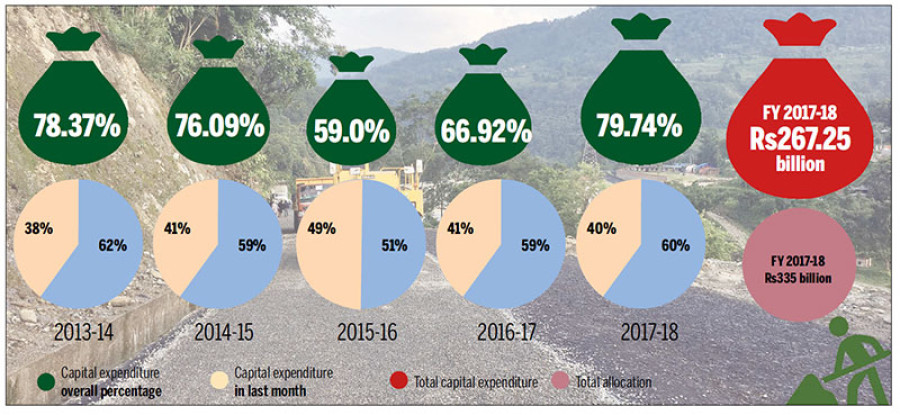Money
Year-end spending rush boosts cap expenditure
Capital expenditure in the last fiscal year 2017-18 ended mid-July reached a five-year high with the government pouring out Rs108 billion in the final month.
Capital expenditure in the last fiscal year 2017-18 ended mid-July reached a five-year high with the government pouring out Rs108 billion in the final month.
Spending on infrastructure development and construction reached 79.74 percent of the budget allocation which is the highest since the fiscal year 2012-13 when spending reached 82.56 percent.
As per the records of the Financial Comptroller General Office (FCGO), capital expenditure amounted to Rs267.25 billion against the allocation of Rs335 billion.
Government officials claimed that the provision of early budget system enabling government agencies to invite tenders early in the year and the provision of treating the programmes and budget as arranged in the Line Ministry Budget Information System as the final approval of programmes are some of the factors that helped boost capital spending.
Other reasons like releasing the budget fully to local units in three installments also played a part in increasing the overall capital spending in the last fiscal year, according to the officials. For example, the government treated the entire fiscal equalization grant transferred to local units in the last fiscal year as complete expenditure although all the resources under the heading of fiscal equalization grant might not have been spent at the local level.
“This might have played a part, if not a big part, in the increase in capital expenditure of the government,” said an FCGO official. Local units are free to use such grants in the priority areas they have set themselves.
“The government’s move to take action against non-performing and under-performing contractors was another reason for the rise in capital expenditure in the last fiscal year,” said Jagannath Devkota, information officer at the FCGO.
However, economists say that non-budgetary expenditure for new projects also contributed to increasing the government’s capital expenditure. “Funds totalling Rs4-5 billion have been allocated for some new projects which are linked with political parties,” said former finance secretary Rameshore Khanal.
Although capital spending swelled in the last fiscal compared to previous years, there has been no change in the trend of late disbursement of the capital budget.
According to the FCGO, the government poured out 40 percent of the total capital budget in the final month of the last fiscal year. The government disbursed Rs108 billion in the last month out of the total expenditure of Rs267.25 billion, according to the FCGO.
Disbursing more than 40 percent of the capital budget in the final month of the fiscal year has been the usual practice in the past half-decade. However, government officials defend the year-end spending rush saying that this does not mean all development tasks are done in the final month—it is payment for tasks completed earlier in the year.
Government agencies say that payment delays have affected development projects as contractors cannot expedite work in time due to lack of resources.
For example, the Roads Department said that construction work on 800 bridges slowed since March, and came to a complete halt in the last month due to lack of payment on time.
Khanal said that although it takes around a month to process payments to contractors, government officials work slow leading to delayed payments.
“Thus, a large portion of payments is made in the closing months of the fiscal year. This practice hinders timely implementation of projects by contractors,” he said.
The spending rush at the end of the fiscal year is a clear sign of elevated fiduciary risk and problem of budget execution, the FCGO said in the Consolidated Financial Statement 2016-17.
Due to delayed payment, contractors scramble to expedite projects at the last minute resulting in poor quality work, government officials said.




 17.12°C Kathmandu
17.12°C Kathmandu













